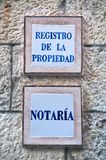In preparation for purchasing a property in Spain, particularly when purchasing a rural property, it is not uncommon to come across discrepancies between data concerning the property surface and boundaries recorded at the Land Registry, the Cadastre, and the effective surface area of the property.
In this article, as experts in the field of PROPERTY LAW here at MSG Legal, we are going to examine the situations in which you may encounter discrepancies between physical descriptions and registry data for a single property, and to provide you with advice regarding which legal tools and instruments are available to settle these kind of issues.

Firstly, we must be aware that two official Registries coexist in Spain, and that they originally acted independently. This has lead to it not being uncommon to encounter discrepancies between physical descriptions of a property (the surface area and boundaries of a property).
These two registries are:
The Land Registry, which falls under the Ministry of Justice, and is the Registry that plays the important role in the Spanish real estate system of ensuring protection of the rights recorded. That is to say, it is in charge of protecting the rights of property owners, providing official confirmation regarding title deeds.
The Real Estate Cadastre, which falls under the Treasury Department, and is a registry of an administrative nature, contains the Description and Title Plans of properties, and is responsible for providing information to the Tax Authorities for the purpose of Property Tax collection.
As we pointed out earlier, the explanation as to why there are mismatches between the data of the two Registries lies in them having existed independently. Furthermore, It was the property owner that provided the descriptive data, giving rise to discrepancies between data and descriptions. For this reason the Spanish government has, over years, established corrective measures to unify and harmonise data, the most recent and most significant measure being LAW 13/2015.
Since Law (2015) entered into force, when carrying out any real estate transaction, it is an essential requirement to follow the procedure in place to coordinate data registered at the Land Registry and the Cadastre, and to adapt the registered data to the physical reality of the property. Property owners, or new owners holding property in Spain, are required to coordinate the descriptive data registered at the Cadastre and the Land Registry, when recording data at these Registries such as consolidations, partitions…
The Regulations provide for a number of legal remedies to settle possible existing discrepancies, courses of action that we can advise you on here at MSG Legal:
- Registry of georeferenced images
- Amending registry or cadastral descriptions
- Registry of building annexes, improvements or new constructions on a property
- Registration procedure for demarcation
- Cancellation of registry data concerning liens or encumbrances, extinguished due to term limitation, expiry or non-use
Expert advice
Property owners can voluntarily decide to initiate the procedure to coordinate records at the Land Registry and the Cadastre with the physical reality of a property. This will provide legal certainty that your property is duly identified, and will ensure full coordination between the Cadastre and the Land Registry. As a result your property will be revalued in view of a future sale.
On the other hand, a correct CONVEYANCING service carried out by a lawyer with expertise in property law, would imply checking the records at the Land Registry and the Cadastre as a standard security measure to purchasing property in Spain. This is in order to detect any possible discrepancies, and If required, provide you with the corrective legal measures available under legislation, with the aim of ensuring that your purchase is safe and aligned with the physical reality of the property.
At MSG we can resolve any doubts you may have regarding discrepancies between the descriptions recorded at the Cadastre and the Land Registry, as well as coordinating the alignment of the physical reality of the property with these records. Our lawyers, with expertise in property law will provide you with personalised advise according to the particularities of your specific case.
Please note the information provided in this article is of general interest only and is not to be construed or intended as substitute for professional legal advice.
msg.legal
Hello. I need to mark the boundaries of my property.
I am not sure who does this. Please can you help.